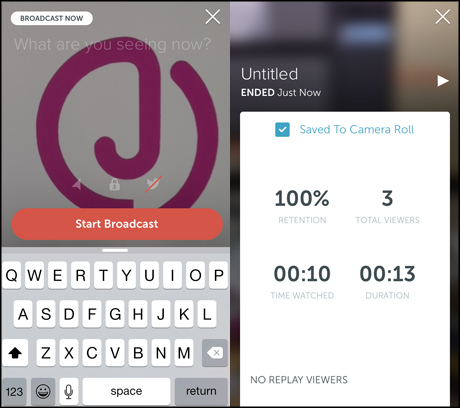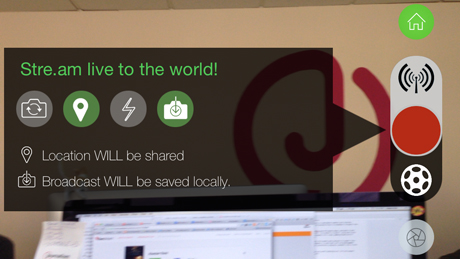
Livestreaming apps are nothing new, but as smartphone cameras and internet connectivity have increased, as have the possibilities to broadcast straight from mobile.
Twitter launched their new livestreaming app Periscope today, and add to that the success of Meerkat, a new app which – for better or worse – has burst onto the tech scene in recent weeks, the prospects for a new, democratised era of broadcasting could be on the horizon.
For journalists and news organisations this means more options to report from news events and interact with the audience in real-time, but the development also increases the chances of citizen journalists playing a greater role in the news.
So here are five livestreaming apps worth checking out, for the casual user all the way up to the seasoned pro.
Periscope
Engadget is already calling Twitter's offering "the best livestreaming app yet" and, as the newest, it does offer a number of improvements over its competitors.
After signing in with Twitter and choosing to follow (or not) a selection of contacts and popular accounts, users are given three options.
The 'watch' section supplies a seemingly random selection of livestreams and the choice to view recent saved broadcasts from people you follow. Click on a stream and you can leave comments and 'heart' a stream by tapping the screen.
The 'people' section lets you manage who you are connected with and find popular accounts, but the central broadcast button is the business end.
Before shooting you can name the broadcast, choose whether to leave it public or make it private for selected followers, and toggle the tweet share and geolocation options.
The streaming is smooth but limited to portrait only – the desktop view is slickly responsive, adjusting to the browser window.
Once the broadcast is over you're given some immediate stats on the number of viewers, hearts, comments and cumulative minutes the broadcast received, plus the option to delete the video from public view.
Where Periscope could really stand out for newsrooms, compared to Meerkat, is in the geolocation function.
Subsidiary apps and tools have sprung up around Twitter and Instagram to help people locate images and no doubt the same will happen soon with Periscope, if Twitter don't get there first, letting newsrooms search for streams around news events anywhere in the world.
Pros: geolocation, slick interface, "like" option, private streams, autosave, responsive viewing on desktop
Cons: Direct shares to Twitter only

Screengrabs from before and after broadcasting in Periscope.
Meerkat
Meerkat founder Ben Rubin has become the de facto face of the livestreaming revolution, appearing on television, radio and stage to promote his business and the possibilities it brings.
But despite Meerkat's (intial) popular appeal and smart marketing, it has a number of limitations in terms of its actual functionality.
Signing in with Twitter, users can connect to contacts on Twitter and watch current livestreams. There is also the option to schedule a livestream for some point in the next 24 hours or start streaming immediately.
Filming itself is optimised for portrait view, however, and even when a user switches to shoot in landscape the broadcast will still appear as portrait to the viewer, while cropping the edges of the picture.
What's more, Meerkat zooms in on a seemingly arbitrary segment of the video when viewed on desktop, rendering the stream all but unwatchable. Meerkat streams are not saved within the app either, although you are given the option to download a video to camera roll afterwards.
Twitter recently turned off its social graph for Meerkat – that which allows the app to piggyback on its social network – but with $12m (£8m) in funding announced today for the month old app they should be able to work through any teething problems with relative ease.
It has also already been used by citizen journalists, if only in recording a particularly surly officer of the law in Los Angeles, but there will doubtless be more cases if there have not been already.
Pros: simple, easy to use, scheduled broadcasts, large and social userbase already
Cons: almost unwatchable on desktop, portrait only, Twitter only, no autosave, no geolocation
Stre.am
Stre.am has more social options than Periscope and Meerkat, integrating with Facebook and Google+ as well as Twitter, and a few other features, but limitations too.
There's an activity feed for people you follow and a menu for current livestreams or saved 'reels'.
The same option of broadcasting or recording a reel is available in the filming mode, and reels are saved to the camera roll and posted in the app for 24 hours.
Options to save, share, enable the torch and enable geolcation are all available before and during the stream, and viewers can comment, like, share or flag streams.
At present there is no desktop viewing option whatsoever and filming is only in landscape, no doubt music to the ears of hardcore mobile journalists dismayed by the rise in portrait optimisation for mobile.
Interestingly, the chief technology officer of Stre.am's parent company Infinite Takes let slip on Twitter recently that he was working on a "standalone [social] network" for the app.
@ajreid @newmediajim @GabrielleNYC @MarcSettle @mashable 1 of many reasons why we're building a standalone soc. network for @streamwithadot.
— Jeremy Martin (@jmar777) March 16, 2015
Pros: geolocation, more social integration, live and recorded viewing
Cons: no desktop view

Streaming options in the Stre.am app.
Livestream
Livestream has been around since 2007, almost as long as Twitter, so has built up a number of added options for professionals.
In a recent podcast for Journalism.co.uk, Tim Pool cited Livestream as his app of choice as the stream displays a live bit rate while broadcasting, allowing him to know whether he's still online or just talking into a dead camera.
Alongside the normal options to share the livestream, you can also adjust the focus, take snapshots and add Instagram-like filters to change how it is viewed.
The scheduling options are far more advanced that on other apps, offering design and "geoblocking" options for certain areas.
A big issue for broadcasters though is the sign up process for viewing on desktop – if you tweet a link to your livestream and an unregistered user follows it they will have to sign up.
This is not necessary on mobile however, where audiences invariably have less patience.
For broadcasters with more professional equipment, the app can connect to GoPro Hero cameras via bluetooth, DSLR cameras via FTP, or even to studio cameras
Pros: connect to other cameras, pro options, filters, scheduling, live and recorded viewing
Cons: must sign up to view on desktop
Ustream
Ustream also launched in 2007, and has a similar array of upgradeable options for producers and their channels including graphics, multiple cameras and more.
On mobile, it's easy to schedule or start broadcasts, and the app has a handy grid system to frame the shot, as well as sharing options for Twitter or Facebook.
The latency – the amount of delay between shooting and viewing – could prove to be an issue on mobile, however, especially when it cuts the video short at the end, meaning you either have to monitor the stream at the broadcast end to know when to stop filming, or leave a gap of anything upwards of 10 seconds to make sure the whole event was broadcast.
The prevalence of ads on the desktop view compared to the full browser may put some viewers off, and although the landscape filming makes for easy viewing, it is not responsive like Periscope.
Pros: shot framing grid, huge userbase, live and recorded viewing, scheduled broadcasts, professional options
Cons: ads, long delay on broadcast
Got any more tips or apps for livestreaming? Feel free to join the conversation in the comments below.
Related articles:
Free daily newsletter
If you like our news and feature articles, you can sign up to receive our free daily (Mon-Fri) email newsletter (mobile friendly).
Related articles
- Livestreaming, explainer videos and newsletters: Overnight election coverage with three new media companies
- New project InOldNews wants to improve representation in video journalism
- 38 mojo apps from BBC trainer Marc Blank-Settle
- 15 online communities for journalists you should know about
- Ukrainian journalists use smartphones to tell stories of displaced communities









